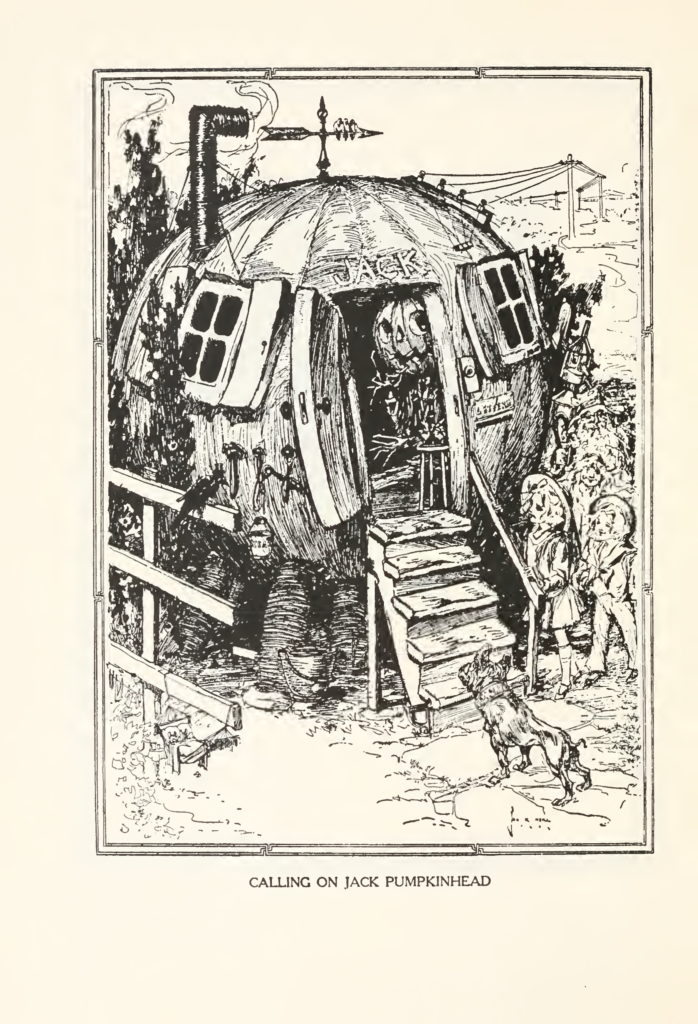
In “Beneath the Surface of Ozma of Oz,” Rahn draws parallels between Baum’s description of the Oz in these two novels and the socialist utopia in William Morris’s News from Nowhere (Rahn 26). The civilized Oz certainly resembles a utopian communist dictatorship but wears the clothing of a hereditary monarchy. There is no rule by the proletariat, for there are no proletariat, landowners, or bosses in Oz, yet there is a single ruler whose legitimacy rests on her being the daughter of the king who ruled before the advent of the Wizard and the Wicked Witches. Private property has been abolished through, paradoxically, the universal private ownership of all property by Ozma, who allows this property to be shared equitably among the people—how fortunate for the Ozites that Ozma stops aging. The abundance of material wealth, particularly gems and precious metals, is used in ostentatious displays, but these resources are common enough that they are ubiquitous among all Ozites. The people receive everything they desire. They work and produce of their own free will for nothing but satisfaction and the benefit of themselves and their neighbors. Baum might as well have included the famous socialist slogan “From each according to his ability, to each according to his needs.”
In the “uncivilized” Oz of the original novels, the economic system is contrary to that outlined in The Emerald City. The Wicked Witches force the Munchkins and Winkies to live in terror and perform slave labor to benefit their rulers, and even among the Ozites themselves there are property-based class differences. The law of the uncivilized Oz is exactly the opposite of that of Ozma’s communal utopia, as the fraud Wizard makes explicit: “You have no right to expect me to send you back to Kansas unless you do something for me in return. In this country everyone must pay for everything he gets” (128). Of course, the Wizard says this knowing he cannot pay Dorothy what he owes her. The contrast to this earlier Land of Oz emphasizes the utopian nature of Ozma’s socialist Oz, which rejects the harsh American “no free lunches” morality the (as yet) unenlightened Wizard carries over from his US homeland. Hence it is civilized, while what came before is not.
The existence of multiple monarchies means Oz cannot be communist in the sense leftists would usually understand the term. However, a communist ideology, as history attests, is by no means incompatible with dictatorship in the normal sense everyone uses, as is present in Baum’s Oz, rather than in the less intuitive sense of the class dictatorship that capital-C Communists intend. Furthermore, the material conditions of Oz are the most ideal version of a one-person communist dictatorship, so the dispute is only semantic, particularly because, unlike existing countries with lived complexity, none of this is real.
Another central aspect is that Oz is pastoral. Even the Emerald City, the largest urban center, has a tiny population of 57318. As Richard Tuerk points out in Oz in Perspective, this is the size of a small town and so a suitable capital for an idealized rural country (197). Note also that the above description of the economy features agriculturalists and artisans but no factories. There is metallurgy used to ornament buildings and people with the abundant gold but no industry or machines.

However, electricity is used: Ozma’s throne room contains “two electric fountains” (Emerald City 54), Oz has the infrastructure for the Shaggy Man to construct a wireless telegraph in The Patchwork Girl of Oz, the Wizard invents cellular phones decades early in Tik-Tok of Oz, and illustrations depict Jack Pumpkinhead’s house having electrical wires (Road 4) and Ozma keeping a telephone on her desk (Emerald City 192). The question of electricity generation is not explained at risk of undermining the fantasy of the redress of all social ills through mutual aid and abundance created without coercive authority. The answer is presumably magic, which Ozma strictly regulates.
In effect, for Oz, magic may correspond to industrial and electrical technology. Consider that Tik-Tok, a robot man, is explicitly a machine but is also magic, proven by how he can only function in fairy lands and not in the mundane world. “I do not sup-pose such a per-fect ma-chine as I am could be made in an-y place but a fair-y land,” as Tik-Tok says (Ozma of Oz 52). The utopian element is in the careful regulation and control of technology, preventing it from overwhelming people’s lives and destroying the idyllic natural beauty that Baum’s narration frequently describes. In the uncivilized Oz, magic runs rampant, the Wicked Witches using it to terrorize and enslave people, while in the “big, cold, outside world,” figures such as the Nome King use magic to similar ends. As Gore Vidal observed, “[C]ontrolled magic enhances the society just as controlled industrialization could enhance (and perhaps even salvage) a society like ours. Unfortunately, the Nome King has governed the United States for more than a century” (quoted in Zipes).